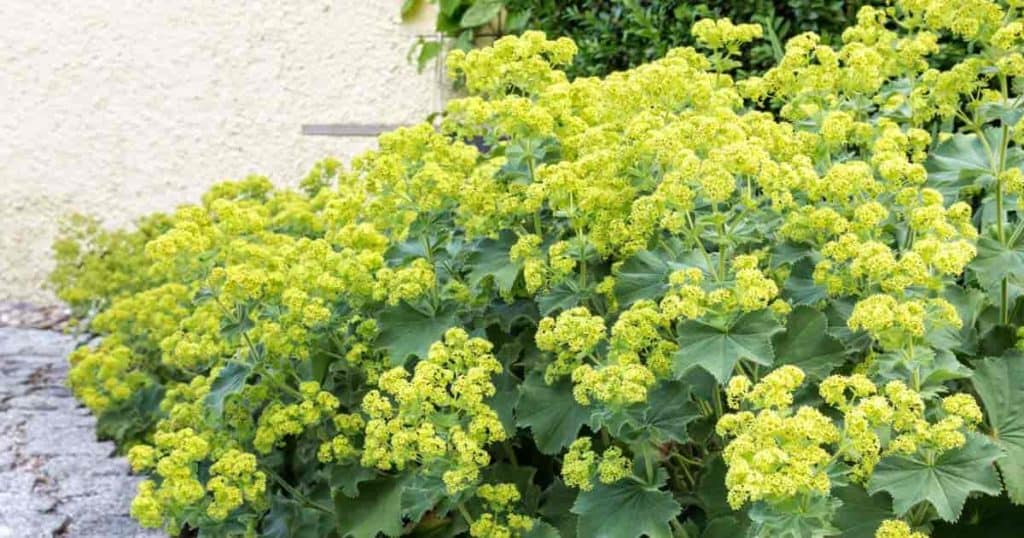The Alchemilla mollis [al-kem-ILL-uh] [MAW-liss] or Alchemilla vulgaris (Little Alchemist) [al-kem-ILL-uh] [vul-GAIR-iss] more widely known by the common name Lady’s Mantle is a member of the Rosaceae family.
Native to Turkey, Carpathian Mountain, and southern Europe with some species cultivated in North America.

The plant’s name comes from an ancient legend it was used to adorn the Virgin Mary whose cloak looked like scalloped leaves.
It’s an herbaceous perennial plant grown throughout the world as an ornamental garden plant.
Other varieties include:
- Alchemilla mollis ‘Thriller’ – Upright growth habit with larger leaves.
- Alchemilla mollis ‘Auslese’ – Upright lime-green flavors.
- Alchemilla mollis ‘Irish Silk’ – 2′ feet tall growing a plethora of blossoms.
- Alchemilla mollis ‘Robusta’ – Featuring larger leaves growing 2′ feet tall.
- Alchemila alpina – Known as Alpine Lady’s Mantle. Smaller with silver edges on leaves.
The name alchemilla is related to the word “alchemy”.
Historically people believed the dewdrops formed on the leaves were the purest form of water capable of turning metals into gold.
It’s still considered to be a magical plant.
Lady’s Mantel Care
Size and Growth
This plant grows up to 12″ – 18″ inches tall and spreads 18″ – 23″ inches.
Flowering and Fragrance
Lady’s Mantle typically blooms around June.
The flowers are showy and look great dried and cut.
The foliage is semi-round with gray-green leaves, looks good all season and makes a nice ground cover.
In late spring and early summer, it produces subtle yellow-green flowers to a covering of chartreuse flowers.
Light and Temperature
The Lady’s Mantle grows in partial shade to full sun.
It prefers part shade in hotter climates but adapts well.
Highly humid areas may create some fungus problems, especially if the crown of the plant is also damp.
Recommended for USDA hardiness zones 3-7.
Watering and Feeding
The Alchemilla mollis is a drought-tolerant plant which doesn’t grow well in wet soil.
If the climate is hot or the plant is experiencing full sun, regular watering is needed to prevent brown and dry leaves.
The plants are self-sow types and don’t need much fertilizer to flourish.
Soil and Transplanting
Lady’s Mantle plants aren’t particular about soil types.
They thrive in slightly acidic to neutral soils with a pH level of 5.5 to 7.5.
Add mulch to the soil around the plant but not up to the flower stems.
The plant stays near the ground and overcrowding will hinder their growth.
It’s very easy to separate and transplants with ease.
- Transfer them in early spring or late summer.
- Dig the entire plant with a shovel and split the root ball with a sharp knife into three equal sized pieces.
- Give each piece ample vegetation so it can grow well.
- Plant all three pieces in new spots and water the area thoroughly.
Regularly water during the growing season so they establish themselves.
Grooming and Maintenance
The soil for Lady’s Mantle should never become too dry.
It needs to be irrigated once a week to remain evenly moist.
This will keep the plant looking verdant and lush.
If you want to prevent seeding, clip off the flower stalks before they can begin seeding.
Any leaves turning brown or yellow in the growing season need to be removed.
After the growing season is complete, the foliage needs to be cut back to the main stems along the ground.
In milder climates, the plant will remain evergreen, so continue trimming as necessary.
How to Propagate Alchemilla
The plant can propagate by division, separation, or seed.
The plants need to be divided by late summer through root division after the plant’s done flowering.
- Plant in well-prepared soil.
- Dig 6″ inches into the soil for planting.
- Add 3″ inches of compost.
- If the soil is too acidic, mix lime into the ground.
Alchemilla Mollis Pests and Diseases
There are no real pests the Lady’s Mantle faces.
Some fungal diseases can become problematic for the plant when it reaches the end of the growing season.
In hot weather, the plant grows shabby if the soil is dry.
Saturate the roots from the ground level instead of merely watering with a soaker hose to help prevent disease.
The Lady’s Mantle is aggressive and self-seeding, which makes it an invasive plant.
It’s important to cut out the flower stalks before they begin seeding if you don’t want any new plants.
In hot climates, the leaves of the plant can scorch.
Make sure the soil isn’t too dry and it gets partial shade during afternoons.
Suggested Uses For Ladies Mantle
Commonly used as ground cover and makes a beautiful edging while kept in bounds.
Cut flowers are perfect in flower arrangements, the yellow flowers mix well with anything.
It’s also great in troughs, pots, and cottage gardens.
